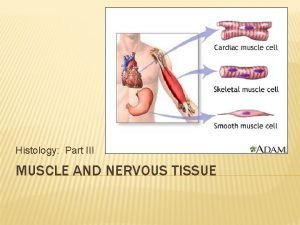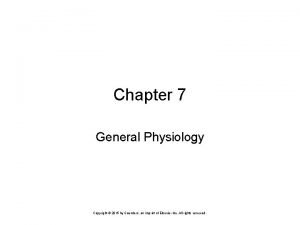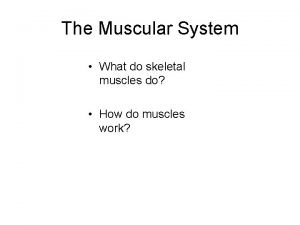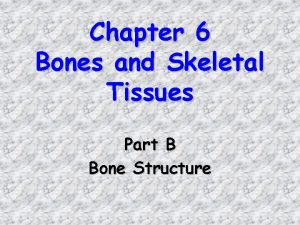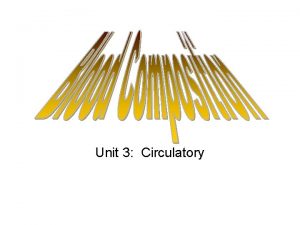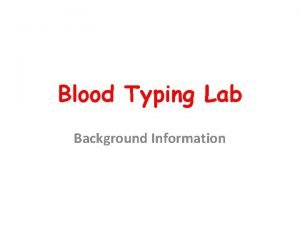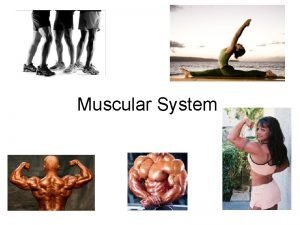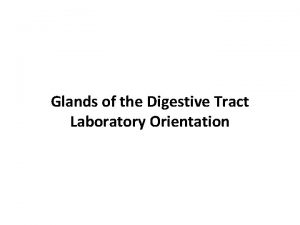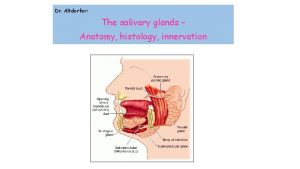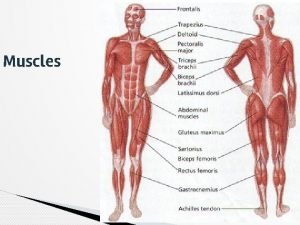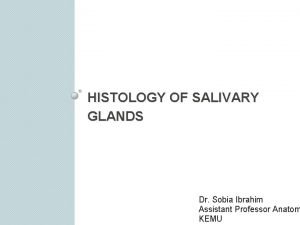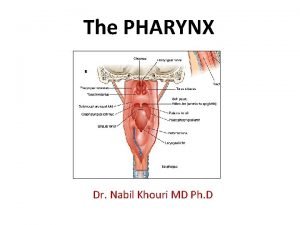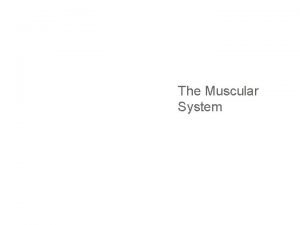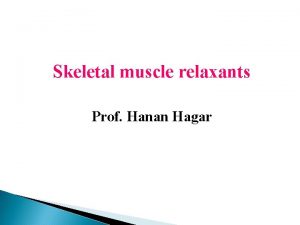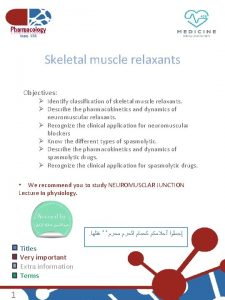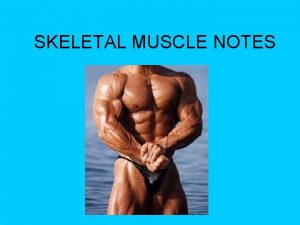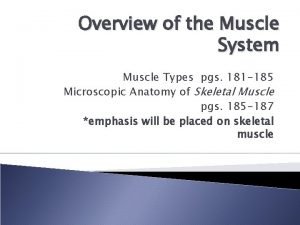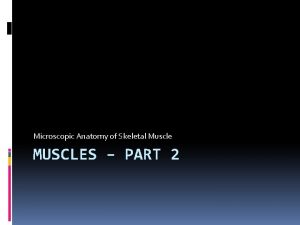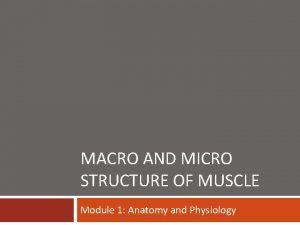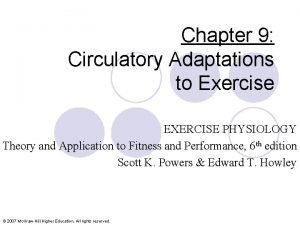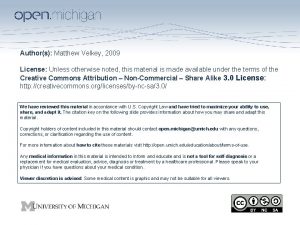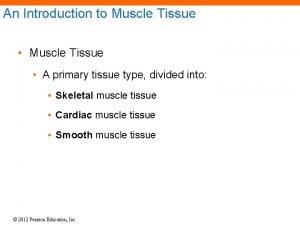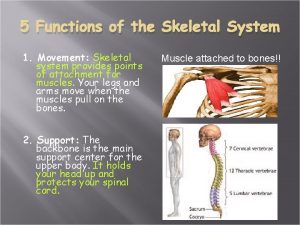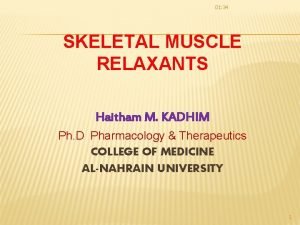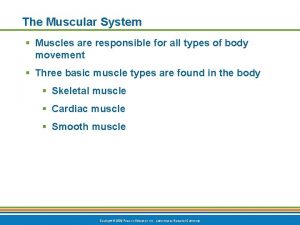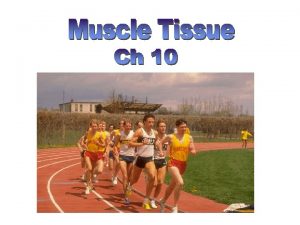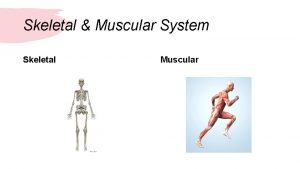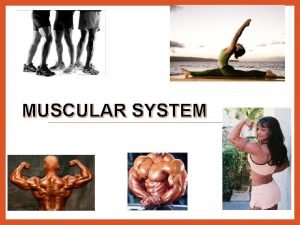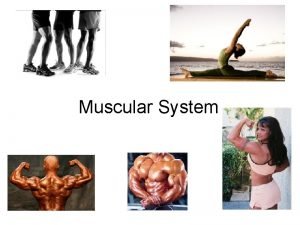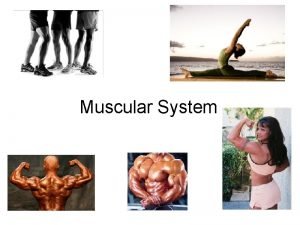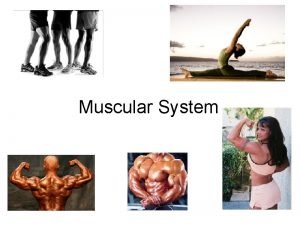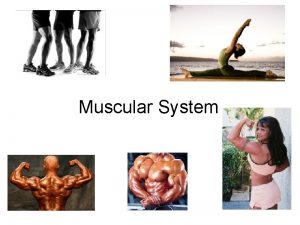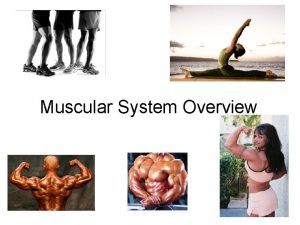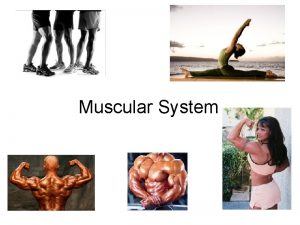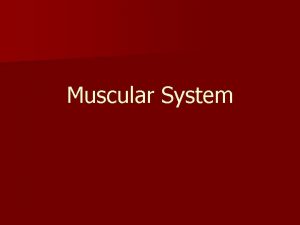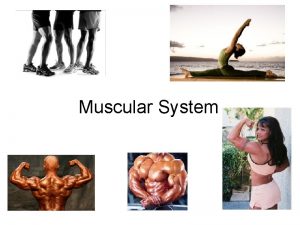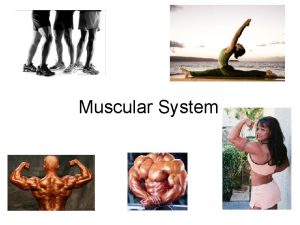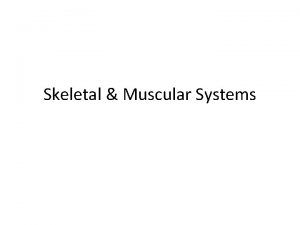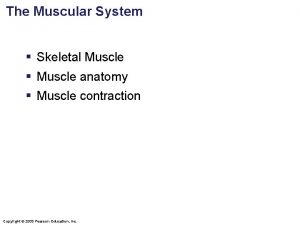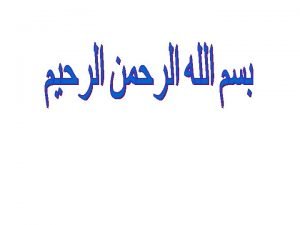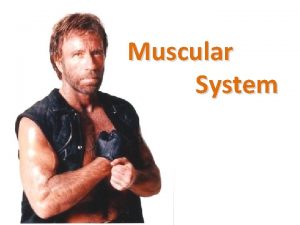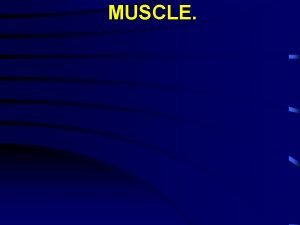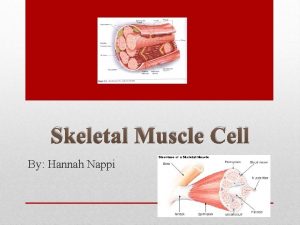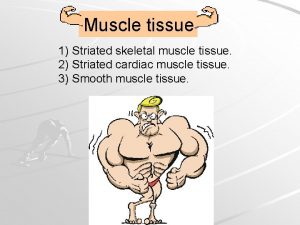The Muscular System Muscle Tissues Skeletal striated multinucleate









































- Slides: 41

The Muscular System

Muscle Tissues Skeletal – striated, multinucleate, voluntary, 10 -100 m Smooth - found in walls of hollow visceral organs; ex. stomach, bladder, respiratory passages; visceral, nonstriated, involuntary; discuss peristalsis Cardiac – in heart only, striated, involuntary, intercalcated disks

Muscle function: • produce movement • maintain posture • stabilize joints • generate heat Functional Characteristics: • Excitability- respond to a stimulus • Contractility- ability to shorten forcibly when adequately stimulated • Extensibility- the ability to be stretched • Elasticity- the ability of a muscle fiber to resume its resting length after being stretched

Skeletal Muscle Tissue

Smooth Muscle Tissue

Cardiac Muscle Tissue

Gross Anatomy Skeletal Muscle

bundle of muscle fibers Muscle Anatomy muscle fiber (cell) myofibril sarcomere

Myofibril

Z lines Sarcomere

Sarcomere A band

Sarcomere I bands

Actin and Myosin Filaments actin myosin

Myosin (Thick) Filament

Actin (Thin) Filament

Sliding Filament Hypothesis

Actin (Thin) Filament No Calcium Ion tropomyosin

Actin (Thin) Filament Calcium Ion Present myosin binding sites tropomyosin

Actin & Myosin Interaction

Biology 100 Human Biology motor neurons spinal cord neuromuscular junctions Motor Unit muscle fibers muscle bundle

Neuromuscular junctions muscle fibers branching axon to motor unit

Stimulation of Skeletal Muscle

axon sarcomere myofibrils plasma membrane

T tubules sarcoplasmic reticulum

T tubule plasma membrane calcium actin sarcoplasmic reticulum myosin head

Muscle Twitch period of relaxation period of contraction latent period stimulus

Contraction Response

Origin- fixed point of attachment; for biceps brachii O= clavicle and humerus Insertion- moveable, usually crosses a joint; O= radius Prime mover- - muscle group responsible for producing particular movement Antagonist- works opposite of prime mover Synergist-reduces undesirable or unnecessary movement Contraction of a muscle crossing 2 or more joints would cause movement of all if synergists weren’t there to stabilize it Ex. make a fist without bending wrist Fixator- specialized synergist- helps maintain posture; ex. muscles of the back fix scapula

Antagonistic Muscles biceps (flexor) triceps (extensor) biceps (flexor)

Naming skeletal muscles: • Direction of muscle fibers- straight, transverse • Size of muscles- maximus, minimus, longus, brevis • Location- frontalis, temporalis, occipitalis • # of origins- biceps, triceps, quadriceps • location of muscles origin and insertionsternoclediomastoid- O= sternum and clavicle, I = mastoid process of temporal bone • shape of muscle- deltoid- triangle shape, trapeziustrapezoid shape • action of muscle- adductor muscle (adducts, brings in thigh)

Frontalis aponerosa Orbicularis oculi temporalis zygomaticus Orbicularis oris Masseter sternocledeomastoid

Temporalis Frontal Obicularis oculi Obicularis oris Masseter Sternoclediomastoid

Cardiac Muscle Tissue

Smooth Muscle Tissue

Slow-Twitch Versus Fast -Twitch Muscle Fibers

Energy for muscle contraction: ATP is the only energy source ATP (ATPase + H 2 O) ADP + Pi ATP is Generated by: 1. creatine phosphate ADP + creatine phosphate creatine + ATP 2. lactic acid fermentation From stored glycogen via anaerobic glycolysis; glucose pyruvic acid (no O 2) lactic acid O 2 3. aerobic respiration Krebs CO 2 + H 2 O + ATP

Fast glycolitic: white muscle fibers, low myoglobin, anaerobic glycolysis, few mitochondria, fast twitch fibers, high glycogen stores, short bursts, fatigues easily Slow oxidative: red muscle, aerobic, high myoglobin, low glycogen stores, lots mitochondria, slow, tonic, long distance Fast glycolitic-oxidative: red pink, aerobic, fast, high myoglobin, intermediate amt. of mitochondria, intermediate glycogen, intermediate fatigue resistance Ratio- red: white (all 3 types in body) Ex. fishlong distance blue fin tuna- mostly red meat quick bursts- yellow tail- more white meat

Long distance Runneraerobic respiration Sprinteranaerobic respiration

Disuse- atrophy Muscles must be physically active if they are to remain healthy Cast muscle strength can decrease at a rate of 5%/ day; can use e- stimulus Avoid muscle injuries: -warm up muscles- walk fast 5 minutes -then stretch- avoids pulls and tares cramp- sustained spasm or tetanic contraction; may be due to low blood sugar levels, electrolyte depletion, dehydration how to care for cramp: RICE strain- muscle pull spasm- tics hernia- protrusion of organ through body cavity wall may be due to heavy wts.

Isotonic and Isometric Contractions Isotonic contraction • Contraction with a change in length • The muscle shortens and movement occurs. Isometric contraction • Contraction without any change in length • The muscle does not shorten and there is no movement produced even though the muscle contracts.

Isotonic and Isometric Contractions Isometric Isotonic
 Motor unit
Motor unit Striated muscles
Striated muscles Which muscle is striated in appearance but resembles smooth
Which muscle is striated in appearance but resembles smooth Gap junction in smooth muscle
Gap junction in smooth muscle Body tissues chapter 3 cells and tissues
Body tissues chapter 3 cells and tissues Body tissues chapter 3 cells and tissues
Body tissues chapter 3 cells and tissues Body tissues chapter 3 cells and tissues
Body tissues chapter 3 cells and tissues Cells form tissues. tissues form __________.
Cells form tissues. tissues form __________. Stained cheek cell
Stained cheek cell Skeletal and muscular system
Skeletal and muscular system Skeletal and muscular system
Skeletal and muscular system Chapter 6 bones and skeletal tissues
Chapter 6 bones and skeletal tissues Somatic motor neuron
Somatic motor neuron Platelets are fragments of multinucleate cells called
Platelets are fragments of multinucleate cells called Platelets are fragments of multinucleate cells called:
Platelets are fragments of multinucleate cells called: Tecido muscular
Tecido muscular Striated duct
Striated duct Parotid nest
Parotid nest Striated triceps
Striated triceps Minor salivary glands
Minor salivary glands Chapter 36 skeletal muscular and integumentary systems
Chapter 36 skeletal muscular and integumentary systems Chapter 14 the skeletal muscular and nervous systems
Chapter 14 the skeletal muscular and nervous systems Differentiate muscular strength from muscular endurance
Differentiate muscular strength from muscular endurance Pharynx skeletal muscle
Pharynx skeletal muscle Golden rules of skeletal muscle activity
Golden rules of skeletal muscle activity Centrally acting skeletal muscle relaxants
Centrally acting skeletal muscle relaxants Skeletal muscle relaxants classification
Skeletal muscle relaxants classification Non depolarizing muscle relaxant classification
Non depolarizing muscle relaxant classification Gangelia
Gangelia Endo peri epi
Endo peri epi Sarcoplasmic
Sarcoplasmic Skeletal muscle relaxants classification
Skeletal muscle relaxants classification Characteristics of skeletal smooth and cardiac muscle
Characteristics of skeletal smooth and cardiac muscle Microscopic anatomy of skeletal muscle
Microscopic anatomy of skeletal muscle Epimysium
Epimysium Organization of muscles
Organization of muscles Skeletal muscle pump
Skeletal muscle pump Skeletal muscle longitudinal section labeled
Skeletal muscle longitudinal section labeled Titin
Titin Skeletal system 5 main functions
Skeletal system 5 main functions Skeletal muscle relaxants classification
Skeletal muscle relaxants classification Microscopic anatomy of skeletal muscle figure 6-2
Microscopic anatomy of skeletal muscle figure 6-2

